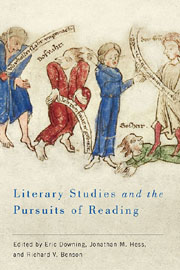Book contents
- Frontmatter
- Contents
- List of Illustrations
- Introduction
- Part I Medieval and Early Modern Practices of Reading
- Part II Reading, Secularization, and Transcendence in the Long Nineteenth Century
- 5 Reading and the Writing of German-Jewish History
- 6 Similia Similibus Curentur: Homeopathy and Its Magic Wand of Analogy
- 7 Reading and Rhetorical Generation: The Example of Blake's Thel
- 8 Sender Glatteis Reads Lessing and Comes to a Sad End: Some Thoughts on Karl Emil Franzos's Der Pojaz and the Problem of Jewish Reading
- Part III Theories and Practices of Reading in the Twentieth Century and Beyond
- Part IV Postscript: The Ends of Reading
- Works Cited
- Notes on the Contributors
- Index
5 - Reading and the Writing of German-Jewish History
from Part II - Reading, Secularization, and Transcendence in the Long Nineteenth Century
Published online by Cambridge University Press: 05 February 2013
- Frontmatter
- Contents
- List of Illustrations
- Introduction
- Part I Medieval and Early Modern Practices of Reading
- Part II Reading, Secularization, and Transcendence in the Long Nineteenth Century
- 5 Reading and the Writing of German-Jewish History
- 6 Similia Similibus Curentur: Homeopathy and Its Magic Wand of Analogy
- 7 Reading and Rhetorical Generation: The Example of Blake's Thel
- 8 Sender Glatteis Reads Lessing and Comes to a Sad End: Some Thoughts on Karl Emil Franzos's Der Pojaz and the Problem of Jewish Reading
- Part III Theories and Practices of Reading in the Twentieth Century and Beyond
- Part IV Postscript: The Ends of Reading
- Works Cited
- Notes on the Contributors
- Index
Summary
Early in 1855, Rabbi Ludwig Philippson opened his weekly newspaper the Jüdisches Volksblatt (Jewish popular paper) with an article warning Jewish parents of a “disease” threatening Jewish family life “from east to west.” The headlines of this issue read “Father, Protect Your Son, Mother, Protect Your Daughter from One Thing, from Reading Novels!” and the one-and-a-half-page diatribe that followed invoked a crisis demanding immediate action:
Frequent reading of novels is poison for the youth, poison for the mind, poison for the heart, poison for education [Bildung], poison for real life! Reading novels is the same as eating opium, the same as intoxication from drinking brandy. Lending libraries are the open stalls where this poisoning happens, and now even schools are setting up similar boutiques. With rather cheap editions [of novels] coming out now, everyone can create his or her own storehouse of this unnerving, deafening material. Yes, novels, like opium, produce a curvature of the spine for the spirit.… You ask for proof? Let me tell you, I have seen excessive reading of novels make people prone to mental confusion, and in these cases reading novels gave the initial impetus for madness. Surely, the growing addiction to novels is one of the reasons why insanity is now on the rise, and indeed, there is statistical proof that madness is rising now particularly among Jews.… Do not believe that I am exaggerating! Long years of experience and observation have convinced me of this.
- Type
- Chapter
- Information
- Literary Studies and the Pursuits of Reading , pp. 105 - 129Publisher: Boydell & BrewerPrint publication year: 2012

